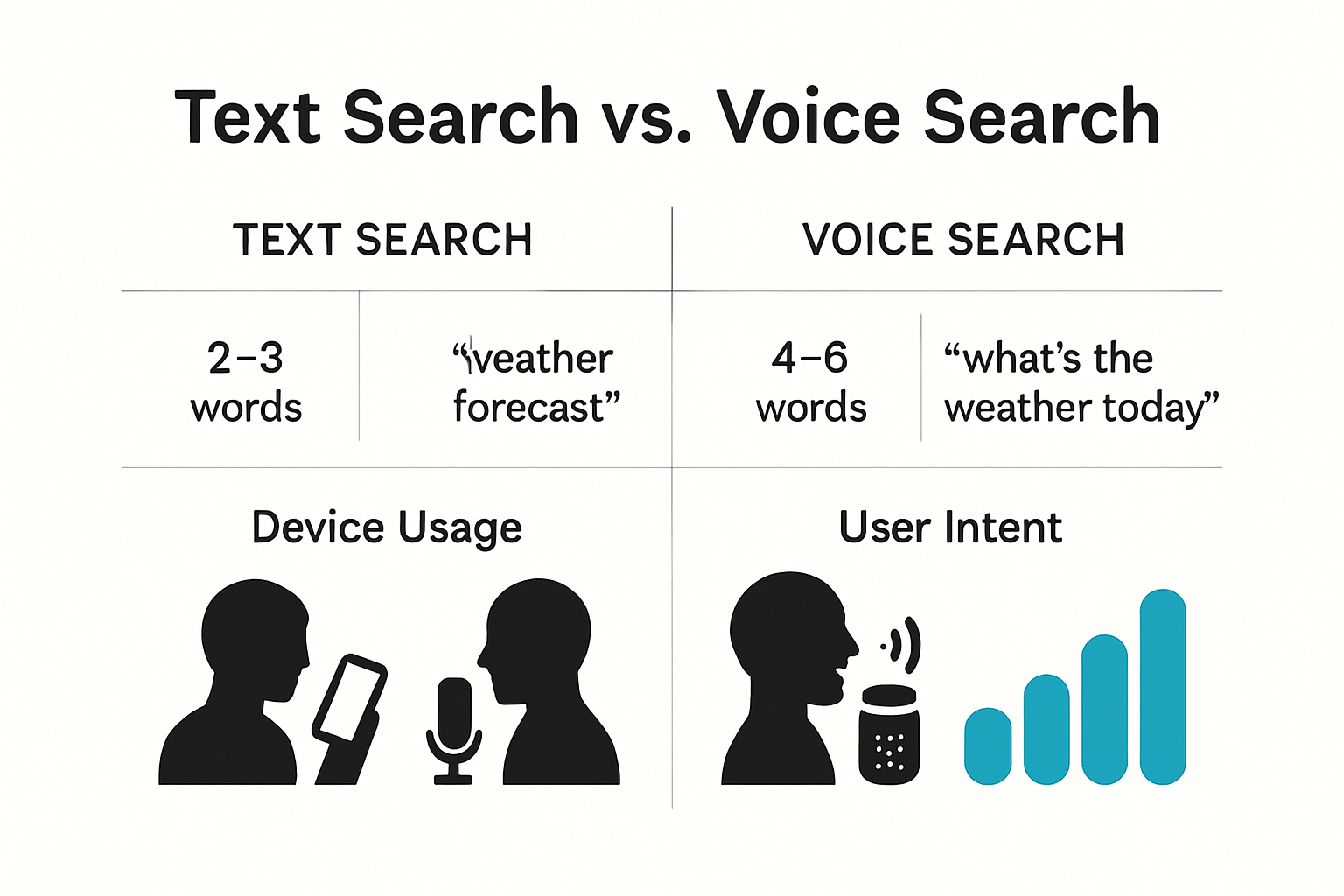Voice search is shaking up the way people find answers online. Instead of short keywords, over 70 percent of voice searches use natural, full-sentence questions. Most folks still picture someone texting quick phrases into a search bar, but this old method is quickly becoming outdated. Talking to your device and getting instant, direct answers is turning into the new normal and that means websites need to completely rethink how they show up online.
Table of Contents
- What Is Seo For Voice Search And How Is It Different?
- Why Voice Search Matters For Your Online Visibility
- How Voice Search Impacts User Behavior And Search Intent
- Key Concepts And Techniques In Optimizing For Voice Search
Quick Summary
| Takeaway | Explanation |
|---|---|
| Voice search uses conversational queries. | Unlike traditional searches, voice queries are often full sentences that prioritize natural language communication. |
| Optimize for specific questions. | Content should directly answer users’ spoken questions to enhance visibility and engagement in voice search. |
| Leverage local relevance. | Voice searches frequently focus on location-based queries, requiring businesses to optimize content for local context. |
| Implement structured content strategies. | Use clear Q&A formatting and schema markup to help search engines interpret your content effectively for voice queries. |
| Aim for concise, authoritative answers. | Voice searches often highlight a single top result, making it crucial to provide accurate and succinct information. |
What is SEO for Voice Search and How is it Different?
Voice search represents a transformative approach to digital information retrieval, fundamentally changing how users interact with search engines and digital devices. Unlike traditional text-based searches, voice search leverages natural language processing and advanced speech recognition technologies to understand and respond to spoken queries.
The Fundamental Differences in Search Behavior
Traditional text searches typically involve short, fragmented keyword phrases like “Italian restaurant downtown.” In contrast, voice searches are characterized by conversational, full-sentence queries that mimic natural human communication. Users are more likely to ask complete questions such as “What are the best Italian restaurants near me right now?”

To help clarify the main differences between traditional text search and voice search, the following table compares their behaviors, query types, and content requirements as discussed in the article.
| Aspect | Traditional Text Search | Voice Search |
|---|---|---|
| Query Style | Short, fragmented keywords | Conversational, full-sentence questions |
| Example | Italian restaurant downtown | What are the best Italian restaurants near me? |
| Language Used | Keyword-optimized, less natural | Natural language, everyday speech |
| Content Optimization | Keyword-focused | Question-focused, direct answers |
| Result Selection | Multiple results shown | Often single, top authoritative answer |
| Local Relevance | Less emphasis | High emphasis on local/contextual intent |
| Length of Query | Short (1-3 words) | Longer (full sentences, more context) |
This shift in search behavior demands a radically different SEO strategy. Voice search optimization requires content that directly answers specific questions, uses natural language, and provides precise, concise information. Learn more about semantic search strategies that can help adapt to these emerging search patterns.
Technical Mechanisms Behind Voice Search
Voice search relies on sophisticated technologies that transform spoken words into searchable queries. Key technological components include:
The core technologies powering voice search work together to accurately interpret and respond to spoken user queries. This table briefly defines each technology and its role, as described in the article.
| Technology | Purpose/Function |
|---|---|
| Speech Recognition | Converts spoken language into text |
| Natural Language Processing | Interprets context and intent behind spoken queries |
| Machine Learning Algorithms | Improves understanding of linguistic nuances over time |
| Digital Assistants | Devices/services (e.g., Siri, Google Assistant, Alexa) that use these technologies to understand spoken instructions |
- Speech Recognition: Converts spoken language into text with increasing accuracy
- Natural Language Processing: Interprets the context and intent behind spoken queries
- Machine Learning Algorithms: Continuously improve understanding of linguistic nuances
These technologies enable digital assistants like Siri, Google Assistant, and Alexa to comprehend complex, context-rich spoken instructions. According to research from EdC Paris, voice searches are becoming increasingly sophisticated, understanding not just words but the underlying user intent.
For SEO professionals and content creators, this means developing content that sounds natural, answers specific questions directly, and anticipates the conversational patterns users employ when speaking to digital devices.
Why Voice Search Matters for Your Online Visibility
Voice search has rapidly transformed digital interaction, becoming a critical component of modern search strategies for businesses and content creators. As digital devices become increasingly sophisticated, understanding the significance of voice search is paramount for maintaining and improving online visibility.
The Growing Prevalence of Voice Search
The adoption of voice search technologies has been exponential. Smartphones, smart speakers, and digital assistants have made voice queries more accessible and convenient than ever before. Users can now effortlessly ask questions, request information, and perform searches without typing a single word.
This technological shift means businesses cannot afford to ignore voice search optimization. Discover advanced search engine evolution strategies that can help you stay ahead in this rapidly changing digital landscape.
Impact on Search Engine Rankings and User Experience
Voice search fundamentally alters how search engines evaluate and rank content. Unlike traditional text searches, voice queries prioritize:
- Conversational Content: Natural language that directly answers specific questions
- Local Relevance: Geographically targeted information for immediate user needs
- Immediate Accuracy: Precise, concise answers that address user intent
According to research from the Arizona Technology Council, voice search often returns a single, most authoritative result. This means ranking at the top becomes crucial for businesses seeking maximum online visibility.
By understanding and adapting to voice search dynamics, organizations can significantly enhance their digital presence, improve user engagement, and stay competitive in an increasingly voice-driven search ecosystem.
How Voice Search Impacts User Behavior and Search Intent
Voice search represents more than just a technological advancement. It fundamentally transforms how users interact with digital information, creating a profound shift in search behavior, communication patterns, and intent recognition.
The Psychology of Conversational Search
User interactions with voice search are inherently more natural and conversational compared to traditional text-based queries. Instead of typing fragmented keywords, users now speak complete sentences that reflect genuine human communication. This shift means search queries become more contextual, nuanced, and emotionally driven.
Explore the evolution of semantic search strategies to understand how language patterns are revolutionizing digital interactions.
Search Intent Transformation
Voice search fundamentally changes how users express their search intent. Key behavioral modifications include:
- Question-Based Queries: Users ask complete questions rather than typing keywords
- Immediate Information Expectations: Desire for direct, concise answers
- Localized and Personalized Results: Stronger emphasis on context and personal relevance
According to research from the National Library of Medicine, voice-based queries are significantly longer and more contextually rich compared to text searches. This means search engines must now interpret complex, conversational language to deliver precise results.
Behavioral Implications for Digital Interactions
The rise of voice search signals a broader transformation in digital communication. Users are increasingly comfortable interacting with technology through natural language, expecting intelligent, context-aware responses. This trend extends beyond search, influencing how people engage with digital assistants, smart home devices, and interactive technologies.
Understanding these behavioral shifts is crucial for businesses, marketers, and content creators who want to remain relevant in an increasingly voice-driven digital ecosystem.
Key Concepts and Techniques in Optimizing for Voice Search
Voice search optimization represents a sophisticated approach to digital content strategy that goes beyond traditional SEO techniques. Understanding and implementing these specialized strategies can significantly enhance a website’s visibility and relevance in voice-driven search environments.
Long-Tail Keywords and Natural Language
Conversational keyword strategies are the cornerstone of effective voice search optimization. Unlike traditional keyword approaches, voice search demands longer, more natural language phrases that mirror everyday speech patterns. This means moving away from fragmented keywords and embracing full-sentence, question-based search terms.
Dive deeper into semantic search strategies to understand the nuanced language of voice search optimization.
Structured Content and Featured Snippets
Voice search algorithms prioritize content that provides direct, concise answers to user queries. Key optimization techniques include:
- Question and Answer Formatting: Structuring content to directly address specific questions
- Featured Snippet Optimization: Creating clear, concise content that can be easily extracted
- Semantic Markup: Using schema and structured data to help search engines understand content context
According to research from the U.S. Department of Energy, incorporating long-tail keywords and precise answering techniques dramatically improves the likelihood of being selected as a voice search result.
Local and Contextual Relevance
Voice search optimization requires a hyperlocal and hyper-contextual approach. Geographical targeting and immediate context understanding become paramount. This means creating content that not only answers questions but also provides location-specific, immediately actionable information.

By focusing on natural language, structured content, and contextual relevance, businesses can position themselves effectively in the evolving landscape of voice-driven search technologies.
Ready To Win the Voice Search Revolution?
Your business deserves to be heard in this new era of voice-powered search. But tackling natural language queries, optimizing for featured snippets, and dealing with content overlap can feel overwhelming. The biggest obstacle? Keyword cannibalization quietly chips away at your rankings right when search intent is more conversational than ever.
Take control of your voice search SEO with the #1 trusted solution for consultants and agencies. At RankAligner, you cut through confusion and ensure your key content claims the top spot in both voice and text results. Start now to protect your rankings in this competitive landscape and see how our platform simplifies semantic and cannibalization challenges from day one. Ready to be the clear choice in voice search results? See how RankAligner empowers your SEO strategy today.
Frequently Asked Questions
What is voice search and how does it differ from traditional search?
Voice search allows users to search the internet using spoken queries instead of typing. It differs from traditional search by utilizing natural language processing and recognizing complete sentences, resulting in more conversational and contextual search queries.
How does voice search impact SEO strategies for content creators?
Voice search necessitates an SEO strategy that focuses on natural language, question-based content, and concise answers that directly address user intent, differentiating it from traditional short keyword optimization.
What are the key components to optimize for voice search?
Key components to optimize for voice search include using long-tail keywords, structuring content to directly answer common queries, and leveraging schema markup to help search engines understand the context of your content.
Why is local relevance important for voice search optimization?
Local relevance is crucial for voice search optimization because many voice queries are location-based and seek immediate, actionable information relevant to users’ surroundings. Providing localized content enhances visibility and authority in voice search results.

